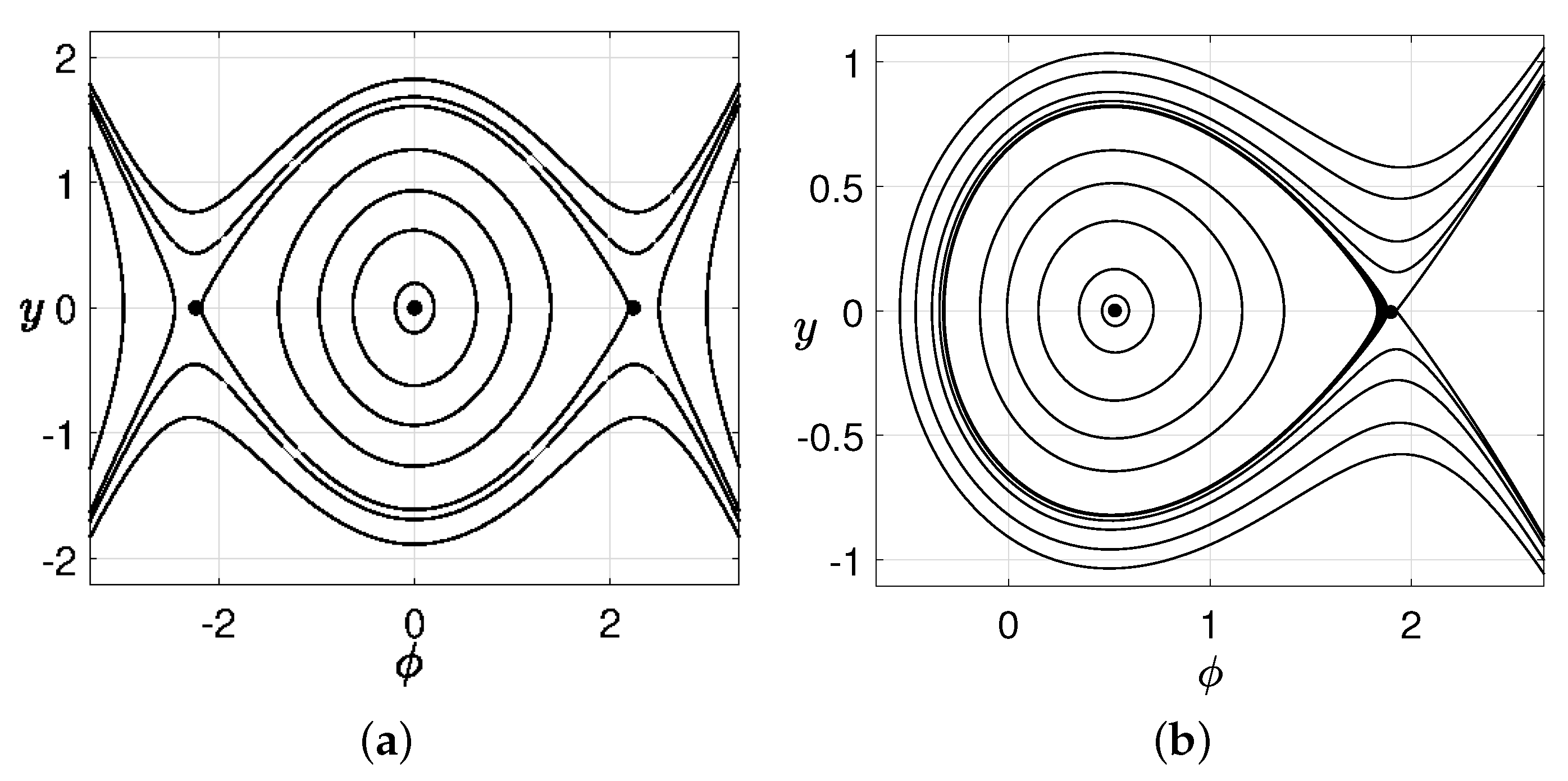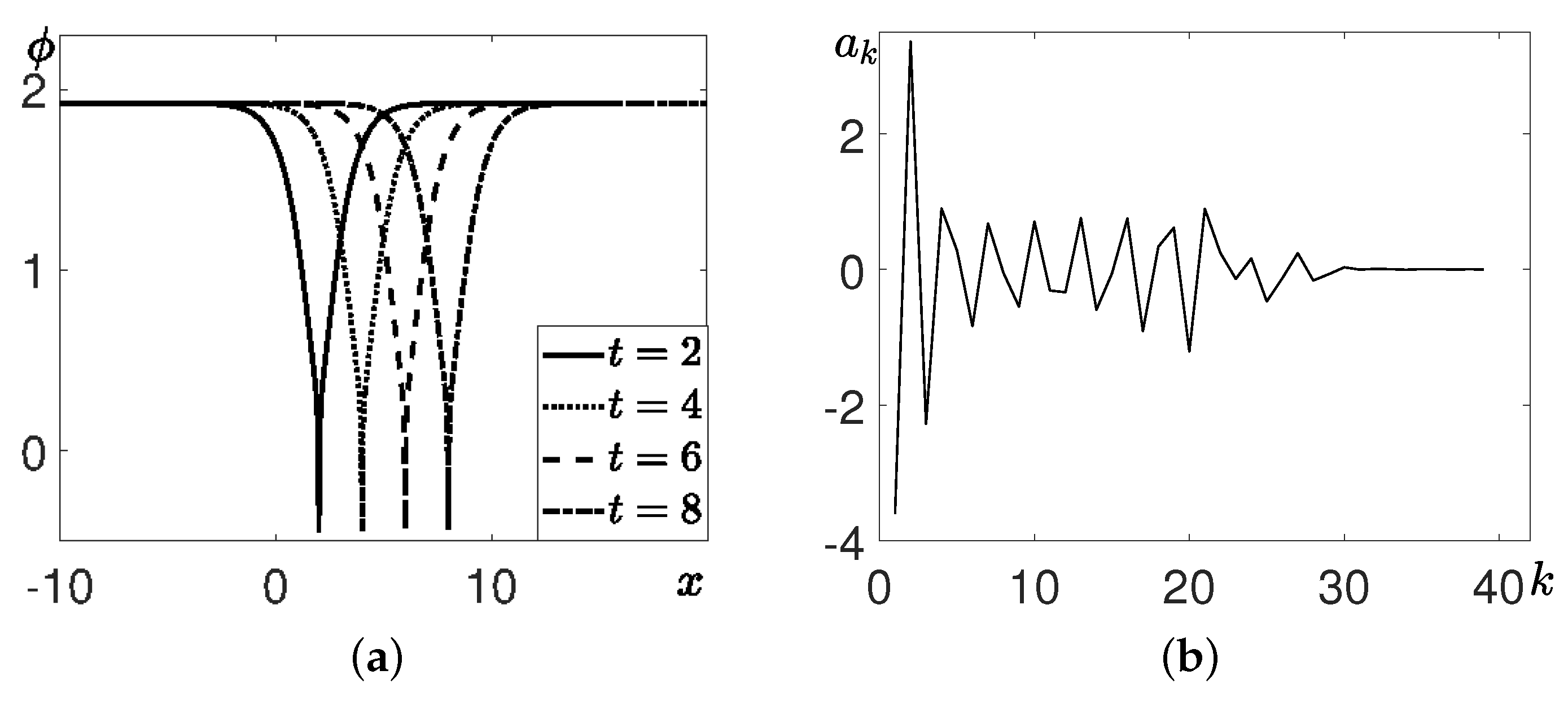Generalized Camassa–Holm Equations: Symmetry, Conservation Laws and Regular Pulse and Front Solutions
Abstract
:1. Introduction
2. Symmetry Analysis and Reductions
2.1. Lie Point Symmetries
- (i)
- For , , and the admitted point symmetries are generated by:
- (ii)
- If , , , d, arbitrary we obtain an additional point symmetries admitted by the Camassa–Holm Equation (3):
- : We obtain the reductionwhere satisfies the equation
- : The reduction is,The reduced ODE is
2.2. Nonclassical Method
- if we can set . We thus obtain a set of nine determining equations for the infinitesimals and . Once solved this system we obtain that the nonclassical method applied to (3) yields to the Lie point symmetries.
- If we can set . We thus obtain an overdetermined nonlinear system of equations for the infinitesimal , which is solved by making ansätze. In this way the following new infinitesimal generator is found:where f is an arbitrary function. Therefore, this transformation reduces the PDE (3) into an ODE. For example, for , where and satisfyrespectively, we obtain the nonclassical symmetry reductionwhere satisfies the Weierstrass elliptic function Equation (18) and satisfies the Lamé Equation (19) [14].
3. Conservation Laws
4. Multireduction Method
- By using the Case 1 conservation law we get the first integral.
- By using the Case 2 conservation law we get the first integral.
- By using the two conservation laws of Case 3 we get the two first integrals.By combining these two first integrals we get the reduced first order ODE
- By using the two conservation laws of Case 4 we get the two first integrals.By combining these two first integrals we get the reduced first order ODE
- By using the two conservation laws of Case 5 we get the two first integrals.By combining these two first integrals we get the reduced first order ODE
- By using the two conservation laws of Case 6, we get the two first integrals.By combining these two first integrals we get the reduced first order ODE
- By using the three conservation laws of Case 7 we get the three first integrals.By combining these three first integrals we get the solution
- By using the Case 8 conservation laws we get the first integral.
- By using the Case 9 conservation laws we get the first integrals.By combining these two first integrals we get the reduced first order ODE
5. Analytic Solutions for Heteroclinic and Homoclinic Orbits of the Traveling-Wave Equation
- (i)
- (ii)
- if v and b have the same sign, the system (92) admits the trivial equilibrium O and the equilibria , with:
6. Conclusions
Author Contributions
Funding
Conflicts of Interest
References
- Camassa, R.; Holm, D. An integrable shallow water equation with peaked solitons. Phys. Rev. Lett. 1993, 71, 1661–1664. [Google Scholar] [CrossRef] [PubMed] [Green Version]
- Monvel, A.B.D.; Kostenko, A.; Shepelsky, D.; Teschl, G. Long-time asymptotics for the Camassa–Holm equation. SIAM J. Math. Anal. 2009, 41, 1559–1588. [Google Scholar] [CrossRef]
- Fuchessteiner, B.; Fokas, A.S. Symplectic structures, their Bäcklund transformation and hereditary symmetries. Physica 1981, D 4, 47–66. [Google Scholar] [CrossRef]
- Cao, C.S.; Holm, D.D.; Titi, E.S. Traveling wave solutions for a class of one-dimensional nonlinear shallow water wave models. J. Dyn. Diff. Eqs. 2004, 16, 167–178. [Google Scholar] [CrossRef]
- Constantin, A.; Escher, J. Global existence and blow-up for a shallow water equation. Ann. Scuola Norm. Sup. Pisa 1998, 26, 303–328. [Google Scholar]
- Li, Y.A.; Olver, P.J. Well-posedness and blow-up solutions for an integrable nonlinearly dispersive model wave equation. J. Diff. Eq. 2000, 162, 27–63. [Google Scholar] [CrossRef] [Green Version]
- Bressan, A.; Constantin, A. Global conservative solutions of the Camassa-Holm equation. Arch. Rational Mech. 2007, 183, 215–239. [Google Scholar] [CrossRef] [Green Version]
- Novikov, V. Generalization of the Camassa-Holm equation. J. Phys. A Math. Theor. 2009, 42, 342002. [Google Scholar] [CrossRef]
- Rehman, T.; Gambino, G.; Choudhury, S.R. Smooth and non-smooth traveling wave solutions of some generalized Camassa-Holm equations. Commun. Nonlinear Sci. Num. Simul. 2014, 19, 1746–1769. [Google Scholar] [CrossRef] [Green Version]
- Matsuno, Y. Smooth multisoliton solutions and their peakon limit of Novikov’s Camassa-Holm type equation with cubic nonlinearity. J. Phys. A Math. Theor. 2013, 46, 365203. [Google Scholar] [CrossRef]
- Tu, X.; Yin, Z. Blow-up phenomena and local well-posedness for a generalized Camassa-Holm equation in the critical Besov space. Nonlinear Anal. Real World Appl. 2015, 128, 1–19. [Google Scholar] [CrossRef]
- Naz, R.; Naeem, I.; Abelman, S. Conservation laws for Camassa-Holm equation, Dullin-Gottwald-Holm equation and generalized Dullin-Gottwald-Holm equation. Nonlinear Anal. Real World Appl. 2009, 10, 3466–3471. [Google Scholar] [CrossRef]
- Bluman, G.W.; Cole, J.D. The general similarity solution of the heat equation. J. Math. Mech. 1969, 18, 1025–1042. [Google Scholar]
- Clarkson, P.A. Nonclassical Symmetry Reduction of the Boussinesq Equation. Chaos Solitons Fractals 1995, 5, 2261–2301. [Google Scholar] [CrossRef]
- Adem, A.R. A (2+1)-dimensional Korteweg-de Vries type equation in water waves: Lie symmetry analysis; multiple exp-function method; conservation laws. Int. J. Mod. Phys. B 2016, 30, 1640001. [Google Scholar] [CrossRef]
- Anco, S.C.; Avdonina, E.D.; Gainetdinova, A.; Galiakberova, L.R.; Ibragimov, N.H.; Wolf, T. Symmetries and conservation laws of the generalized Krichever-Novikov equation. J. Phys. A Math. Theor. 2016, 49, 105201. [Google Scholar] [CrossRef] [Green Version]
- Kara, A.H.; Razborova, P.; Biswas, A. Solitons and conservation laws of coupled Ostrovsky equation for internal waves. Appl. Math. Comp. 2015, 258, 95–99. [Google Scholar] [CrossRef]
- Su, C.Q.; Wang, Y.Y.; Liu, X.Q.; Qin, N. Conservation laws, modulation instability and rogue waves for the localized magnetization with spin torque. Commun. Nonlinear Sci. Num. Simul. 2017, 48, 236–245. [Google Scholar] [CrossRef]
- Anco, S.C. Generalization of Noether’s Theorem in Modern form to Non-Variational Partial Differential Equations. In Recent progress and Modern Challenges in Applied Mathematics, Modeling and Computational Science; Fields Institute Communications: Toronto, ON, Canada, 2017; Volume 79, pp. 119–182. [Google Scholar]
- Anco, S.C.; Bluman, G. Direct construction method for conservation laws of partial differential equations Part II: General treatment. Euro. J. Appl. Math. 2002, 41, 567–585. [Google Scholar] [CrossRef] [Green Version]
- Bluman, G.W.; Cheviakov, A.; Anco, S.C. Applications of Symmetry Methods to Partial Differential Equations; Springer: New York, NY, USA, 2009. [Google Scholar]
- Olver, P.J. Applications of Lie Groups to Differential Equations; Springer: New York, NY, USA, 1993. [Google Scholar]
- Anco, S.C.; Gandarias, M.L. Multi-reduction theory for PDEs with conservation laws. Comun. Nonlinear Sci. Numer. Simulations 2020, 91, 105349. [Google Scholar] [CrossRef]
- Gambino, G.; Tanriver, U.; Guha, P.; Choudhury, A.G.; Choudhury, S.R. Regular and singular pulse and front solutions and possible isochronous behavior in the short-pulse equation: Phase-plane, multi-infinite series and variational approaches. Commun. Nonlinear Sci. Numer. Simul. 2015, 20, 375–388. [Google Scholar] [CrossRef] [Green Version]
- Wang, X. Si’lnikov chaos and Hopf bifurcation analysis of Rucklidge system. Chaos Solitons Fractals 2009, 42, 2208–2217. [Google Scholar] [CrossRef]
- Anco, S.C.; Bluman, G. Direct Construction of Conservation Laws from Field Equations. Phys. Rev. Lett. 1997, 78, 2869–2873. [Google Scholar] [CrossRef]
- Sjöberg, A. Double reduction of PDEs from the association of symmetries with conservation laws with applications. Appl. Math. Comput. 2007, 184, 608–616. [Google Scholar] [CrossRef]
- Sjöberg, A. On double reduction from symmetries and conservation laws, Nonlinear Analysis: Real World. Applications 2009, 10, 3472–3477. [Google Scholar]
- Anco, S.C. Symmetry properties of conservation laws. Internat. J. Modern Phys. B 2016, 30, 1640003. [Google Scholar] [CrossRef] [Green Version]
- Anco, S.C.; Kara, A. Symmetry invariance of conservation laws. Euro. J. Appl. Math. 2018, 29, 78–117. [Google Scholar] [CrossRef]
- Tanriver, U.; Gambino, G.; Choudhury, S.R. Regular and singular pulse and front solutions and possible isochronous behavior in the extended-reduced Ostrovsky equation: Phase-plane, multi-infinite series and variational formulations. Discontinuity Nonlinearity Complex. 2016, 5, 85–100. [Google Scholar] [CrossRef]
- Russo, M.; Choudhury, S.R. Analytic solutions of a microstructure PDE and the KdV and Kadomtsev–Petviashvili equations by invariant Painlevé analysis and generalized Hirota techniques. Appl. Math. Comput. 2017, 311, 228–239. [Google Scholar] [CrossRef]



Publisher’s Note: MDPI stays neutral with regard to jurisdictional claims in published maps and institutional affiliations. |
© 2021 by the authors. Licensee MDPI, Basel, Switzerland. This article is an open access article distributed under the terms and conditions of the Creative Commons Attribution (CC BY) license (https://creativecommons.org/licenses/by/4.0/).
Share and Cite
Bruzón, M.S.; Gambino, G.; Gandarias, M.L. Generalized Camassa–Holm Equations: Symmetry, Conservation Laws and Regular Pulse and Front Solutions. Mathematics 2021, 9, 1009. https://doi.org/10.3390/math9091009
Bruzón MS, Gambino G, Gandarias ML. Generalized Camassa–Holm Equations: Symmetry, Conservation Laws and Regular Pulse and Front Solutions. Mathematics. 2021; 9(9):1009. https://doi.org/10.3390/math9091009
Chicago/Turabian StyleBruzón, Maria Santos, Gaetana Gambino, and Maria Luz Gandarias. 2021. "Generalized Camassa–Holm Equations: Symmetry, Conservation Laws and Regular Pulse and Front Solutions" Mathematics 9, no. 9: 1009. https://doi.org/10.3390/math9091009
APA StyleBruzón, M. S., Gambino, G., & Gandarias, M. L. (2021). Generalized Camassa–Holm Equations: Symmetry, Conservation Laws and Regular Pulse and Front Solutions. Mathematics, 9(9), 1009. https://doi.org/10.3390/math9091009






